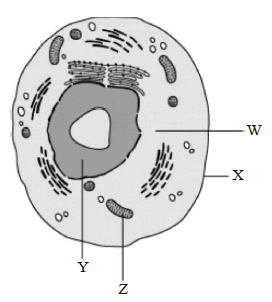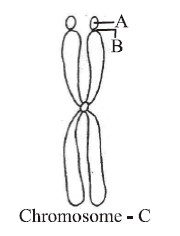Which of the following is absent in prokaryotes?
DNA
RNA
Plasma membrane
Mitochondria
Correct Answer :
D. Mitochondria
Mitochondria are present in the living eukaryotic cells and absent in prokaryotic cells like bacteria and blue-green algae. This organelle is known as the powerhouse of the cell as they are the site of chemical reactions that transfer energy from organic compounds in the form of ATP.
Related Questions
A student placed two cells in the same solution in two different containers. The observation was given in the table.
| Container | Observation |
|---|---|
| 1 | Cell burst |
| 2 | Cell does not change its shape |
Which structure maintains the shape of the cell present in container 2 and provides the most significant difference between the two cells?
Nucleus
Cell wall
Chloroplast
Cell membrane
Lysosomes contain
carbohydrates
hormones
nucleic acids
hydrolases.
Select the incorrect statement about prokaryotic ribosomes.
50S and 30S subunits unite to form 70S ribosomes.
Polysome/polyribosome consists of many ribosomes only.
Ribosome is the site of protein synthesis.
Polysome indicate the synthesis of identical poolypeptide in multiple copies.

Which function is carried out by the cell organelle 'X'?
helps control the movement of substance in and out of the cell
passes information from the parent cell to newly formed cell
maintains the proper shape of the cell and serves as a protective barrier
helps the cell to make food with the help of chlorophyll and sunlight
The cell theory was given in year 1839 by Schleiden and Schwann. According to this theory all organisms are composed of cell and cells are the basic unit of life.
How did this theory help in the field of science?
It helped to study the working of cells.
It helped in curing diseases caused by cell.
It helped in restating the earlier theories on cell.
It helped in introducing the use of microscopes to study cell.
Active transport across biomembrane involves
production of ATP
requirement of energy
production of toxin
release of energy
Which one of the following pairs is not correctly matched?
Cristae The tubular structure formed by the folding of the inner membrane of the mitochondrion.
Plasmodesmata The membrane surrounding the vacuole in plants.
Grana Membrane bound discs in chloroplasts that contain chlorophylls and carotenoids.
Middle lamella Layer between adjacent cells walls in plants derived from cell plate.
Which of the following statement is correct regarding vacuole?
It is membrane-bound and contains storage proteins and lipids.
It is membrane-bound and contains water and excretory substances.
It lacks membrane and contains air.
It lacks membrane and contains water and excretory substances.
In which method of transport, plasma membrane does not require carrier molecule?
Active transport
Facilitated diffusion
Simple diffusion
Na+ K+ pump
Which one of the following structures between two adjacent cells is an effective transport pathway?
Plasmodesmata
Plastoquinones
Endoplasmic reticulum
Plasmalemma
Which one of the following combination is mismatched?
Glycocalyx May be capsule or slime layer
Pili Reproduction
Cell wall Protective, determines shape, prevents from bursting
Flagella, pili and fimbriae Surface structures of bacterial cell
Match column-I and column-II and select the correct answer
| Column-I | Column-II |
|---|---|
| A. Bacteria without walls | I. Lysosome |
| B. Small circular DNA | II. Mycoplasma cells |
| C. Flattened sacs in | III. Thylakoid a chloroplast |
| D. A vesicle in which | IV. Plasmid hydrolytic enzymes are stored |
A III; B IV; C II; D I
A II; B IV; C III; D I
A I; B II; C III; D IV
A IV; B III; C I ; D II
Prokaryotic and eukaryotic flagella differ in the
type of movement and placement.
location and mode of functioning.
microtubular structure and function.
microtubular organization and type of movement.
Active transport differs from passive transport in that active transport
requires energy.
always requires input of ATP.
moves molecules against a concentration gradient.
both (a) and (c)
Membranous extensions in blue green algae are known as
phytochrome
chromatophore
mesosome
pneumatophore
Which of the following terms is not correctly matched with its feature?
Osmosis Movement of water by diffusion.
Nucleoplasm Site of active synthesis of ribosomal RNA.
Mesosome Infolding of cell membrane and characteristics of eukaryotes.
Pili Elongated tubular surface structures (made of special protein) of bacteria.
Which of the following statements are correct ?
- In prokaryotic cells, a special membranous structure formed by the extension of the plasma membrane into the cell is known as polysome.
- The smooth endoplasmic reticulum is the major site for synthesis of glycoproteins.
- RuBisCO is the most abundant protein in the whole biosphere.
- Mitochondria, chloroplasts and peroxisomes are not considered as part of endomembrane system. Of the above statements
(iii) and (iv)
(i) and (ii)
(ii) and (iii)
(i) and (iv)
Match column-I (scientists) with column-II (discovery) and select the correct option.
| Column-I | Column-II |
|---|---|
| A. Leeuwenhoek | I. First saw and described a living cell |
| B. Robert Brown | II. Presence of cell wall is unique to plant cells |
| C. Schleiden | III. Discovered the nucleus |
| D. Schwann | IV. All plants are composed of different kind of cells |
A I, B III, C IV, D II
A I, B III, C II, D IV
A III, B I, C IV, D II
A I, B IV, C II, D III
Centrioles and centrosomes occur in the cells of
green plants
animals
bacteria and cyanobacteria
both (b) and (c)
Which of the following pair are correctly matched.
A. Microtubules Structural components of cilia
B. Centrioles Store hydrolytic enzymes
C. Amyloplasts Store oil protein and starch in plants
A, B and C
A and B
A
A and C
In which of the following the cells are held together by a Ca-pectate layer?
Primary cell wall
Secondary cell wall
Middle lamella
Tertiary cell wall
Which of the following statements is/are correct ?
- The endomembrane system includes plasma membrane, ER, Golgi complex, lysosomes and vacuoles.
- ER helps in the transport of substances, synthesis of proteins, lipoproteins and glycogen.
- Ribosomes are involved in protein synthesis.
- Mitochondria help in oxidative phosphorylation and generation of ATP.
(ii), (iii) & (iv)
(i) only
(ii) only
(iii) only
The given diagram shows the types of chromosomes (labelled as A, B, C & D) based on the position of centromere.
Which one is the correct option for the labelled chromosomes. A, B, C and D ?

A Telocentric chromosome, B Acrocentric chromosome, C Submetacentric chromosome, D Metacentric chromosome
A Acrocentric chromosome, B Telocentric chromosome, C Metacentric chromosome, D Submetacentric chromosome
A Submetacentric chromosome, B Metacentric chromosome, C Telocentric chromosome, D Acrocentric chromosome
A Metacentric chromosome, B Submetacentric chromosome, C Acrocentric chromosome, D Telocentric chromosome.
Match column-I with column-II and choose the correct option.
| Column-I | Column-II |
|---|---|
| (Chromosome) | (Position of Centromere) |
| A. Metacentric | I. At the tip |
| B. Submetacentric | II. Almost near the tip |
| C. Acrocentric | III. At the middle |
| D. Telocentric | IV. Slightly away from the middle |
A III; B IV; C II; D I
A IV; B III; C II; D I
A I; B II; C III; D IV
A IV; B III; C I ; D II
Extension of plasma membrane in prokaryotic cell is
mesosome
haploid
ribosome
none of these
The best way to identify a cell as either prokaryotic or eukaryotic is to determine whether
it came from a single-celled or multicellular organism.
it has a nucleus.
it has a plasma membrane.
it has cytosol.
The figure below shows the structure of a mitochondrion with its four parts labelled (A), (B), (C) and (D).

Select the part correctly matched with its function.
Part (D): Outer membrane Gives rise to inner membrane by splitting.
Part (B): Inner membrane Forms infoldings called cristae.
Part (C): Cristae Possess single circular DNA molecule and ribosomes.
Part (A): Matrix Major site for respiratory chain enzymes.
Basal bodies are associated with the formation of
phragmoplast
cilia and flagella
cell plate
kinetochore
The following diagram represents a structure chromosome.
Identify the structures marked as A, B and C.

A - Satellite, B - Primary constriction, C - Acrocentric
A - Satellite, B - Secondary constriction, C - Metacentric
A - Satellite, B - Centromere, C - Telocentric
A - Satellite, B - Centromere, C - Submetacentric
Match column-I with column-II and select the correct option.
| Column - I | Column - II |
|---|---|
| A. Golgi apparatus | I. Storage |
| B. Mitochondria | II. Photosynthesis |
| C. Vacuoles | III. Transport |
| D. Grana | IV. Secretion |
| .. | V. Respiration |
A - IV, B - V, C - I, D - II
A - I, B - II, C - IV, D - III
A - IV, B - I, C - II, D - III
A - I, B - II, C - III, D - IV
